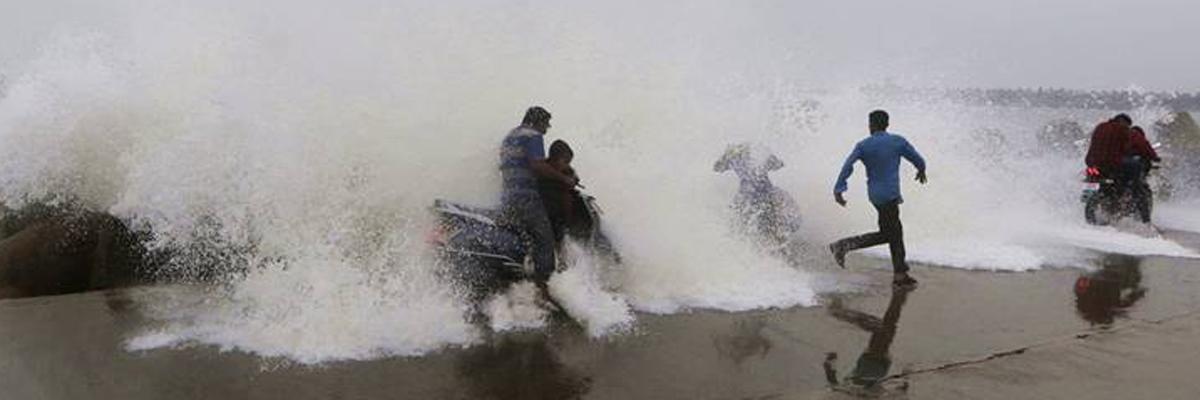Live
- BJP urges EC to stop Cong’s ‘Guarantee Cards’ campaign aimed to 'induce voters'
- Congress cheated Madigas: Dr. RS Praveen Kumar
- CBDT signs record 125 pacts to ease tax payments by big multinational firms
- Kamal Nath accuses BJP of ‘threatening’ Congress leaders in Chhindwara
- Odisha: BJP, BJD allege violation of MCC
- PM Modi lands in Guwahati to kickstart poll campaign
- ‘100 day action plan’ is PM Modi’s signature style for setting goals and meeting targets
- BJP will change the Constitution if they come to power again, says Priyanka Gandhi
- BJP-led NDA to cross 390-mark in Lok Sabha polls, predicts India TV-CNX survey
- Haier launches new TV series in four sizes in India
Just In

Andhra Pradesh coast between Ongole and Machilipatnam is extremely vulnerable to high surges and floods The State is now facing with another risk of getting battered by Phethai cyclone
Andhra Pradesh coast between Ongole and Machilipatnam is extremely vulnerable to high surges and floods. The State is now facing with another risk of getting battered by Phethai cyclone.
Though the government has put entire administration on high alert and taken all measures that are required to provide necessary relief and rehabilitation to the effected people, it can only mitigate the impact and loss of life but there is every possibility of heavy loss being suffered by the State in terms of crop loss and property loss.
The record of history of cyclones from 1975 indicates that Andhra Pradesh faced more than 60 cyclones. While some were not so serious in nature some were very severe. According to weather experts, there has not been even a single year in the last four decades when the State did not witness cyclone, floods or heavy storms.
Though compared to 1977 when the cyclone proved to be deadliest in which 10,000 people were killed and 25,000 cattle heads perished, about one million houses were damaged and crops in 1.35 million hectares destroyed, the government has been able to develop a system with the use of modern technology to mitigate the damage, particularly in terms of loss of human life.
Still the battering a State receives from the cyclone poses several post cyclone challenges like restoration of drinking water, repair of damaged houses, roads, electric poles, restoration of power and supply of essentials like milk and vegetable etc.
According to the State Disaster Management Department, vulnerability to storm surges is not uniform along the coast of Andhra. The stretch between Nizampatnam in Guntur district and Machilipatnam in Krishna district is the most prone to storm surges.
East and West Godavari districts, with vast stretches of paddy fields and irrigation, drainage canals always bear the brunt of cyclones accompanied by strong winds and pounding rains. In the aftermath of cyclones, these areas get flooded, leading to huge crop losses besides other damage.
A severe cyclonic storm had hit the coast in 1990 in May, in which the death toll was 817 and the State’s loss was assessed at Rs 2,137 crore. In the cyclone of May 1979, more than 700 people lost lives.
In 2010, seven people were killed in the coastal districts when Cyclone Laila arrived. It made a landfall near Baptala in Guntur district on May 20 before monsoon. Harvested paddy in Krishna, Guntur and West and East Godavari districts was damaged badly, leaving farmers distraught.
The most unfortunate aspect is lack of human outlook both among the Union government and majority of the people particularly the traders who tend to jack up the prices manifold to make few quick bucks and add to the miseries of the affected people.
The Union government which should extend a helping hand to the battered State takes very long time to release necessary funds thanks to bureaucratic red-tapism. Though it can release funds from National Disaster Response Fund for emergency response, relief and rehabilitation, it is not released in real time. Thanks to red-tapism. The teams to assess the damage visit the State when normalcy is restored.
Even the NGOs, government agencies and all voluntary organisations should coordinate and take up relief work rather than do something for the sake of publicity. Once semblance of normalcy returns, people from other parts jump into action and make a big show of the material they send.
While the gesture is admirable, what is unfortunate is due to lack of coordination with the local administration, tons of old clothes are sent which does not help people in any manner.
Some people distribute food packets but since the time gap between cooking large quantity of food and distribution is huge, it gets spoiled. Instead, all such organisations which want to distribute food would be doing a better job if they can carry the essential supplies to the village they want to help and cook the food at some nearby place and distribute it. Succour should be the motive not publicity.

© 2024 Hyderabad Media House Limited/The Hans India. All rights reserved. Powered by hocalwire.com







